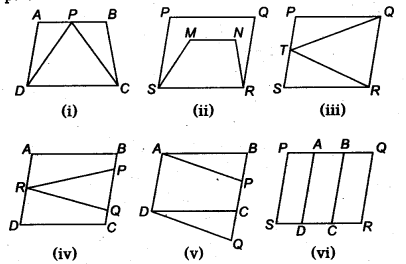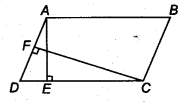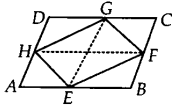| Files Overall Price: | 0.00 | |
| Videos Overall Price: | 0.00 | |
| Total Overall Price: | 0 | |
| Sold By: | Pooja Singla |
Description Above File
NCERT Solutions for Class 9 Maths Chapter 9 Areas of Parallelograms and Triangles
NCERT Solutions for Class 9 Maths Chapter 9 Areas of Parallelograms and Triangles are prepared by CBSE student eCARE expert to score good marks in class 9. This chapter contain many topics which are very important to score good in class 9. There are some important topic/Activity mentioned below:
Which of the following figures lie on the same base and between the same parallels. In such a case, write the common base and the two parallels.

Solution:
The figures (i), (iii) and (v) lie on the same base and between the same parallels.
| Common base | Two parallels | |
| Fig. (i) | DC | DC and AB |
| Fig. (iii) | QR | QR and PS |
| Fig. (v) | AD | AD and BQ |
Download or View Content
Description Below File
Some questions are asked by class 9 students related to Maths
Question 1.
In figure, ABCD is a parallelogram, AE ⊥ DC and CF ⊥ AD. If AB = 16 cm, AE = 8 cm and CF = 10 cm, find AD.

Solution:
BSOWe have, AE ⊥ DC and AB = 16 cm
? AB = CD [Opposite sides of parallelogram]
∴ CD = 16 cm
Now, area of parallelogram ABCD = CD x AE
= (16 x 8) cm2 = 128 cm2 [? AE = 8 cm]
Since, CF ⊥ AD
∴ Area of parallelogram ABCD = AD x CF
⇒ AD x CF = 128 cm
⇒ AD x 10 cm = 128 cm2 [? CF= 10 cm]
⇒ AD = 12810 cm = 12.8 cm 10
Thus, the required length of AD is 12.8 cm
Ex 9.2 Class 9 Maths Question 2.
If E, F, G and H are respectively the mid-points of the sides of a parallelogram ABCD, show that ar (EFGH) = 12 ar (ABCD).
Solution:
Join GE and HE, where GE || BC || DA and HF || AB || DC
(? E, F, G and H are the mid¬points of the sides of a ||gm ABCD).
If a triangle and a parallelogram are on the same base and between the same parallels, then A E U the area of the triangle is equal to half the area of the parallelogram.

Now, ?EFG and parallelogram EBCG are on the same base EG and between the same parallels EG and BC.
∴ ar(?EFG) = 12ar(?gmEBCG) … (1)
Similarly, ar(?EHG) = 12ar(?gmAEGD) …(2)
Adding (1) and (2), we get
ar(?EFG) + ar(?EHG) = 12ar(?gmEBCG)+12ar(?gmAEGD)
= 12ar(?gmABCD)
Thus, ar(EFGH) = 12ar(ABCD)